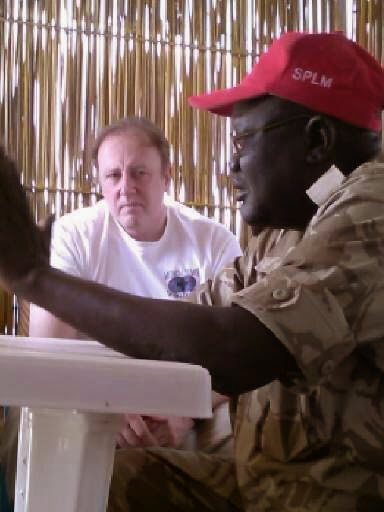An article by the most recent person on the End Nuba Genocide Team who went to Sudan in December.
Africa Views - Nuba Mountains people are starving to death, but who cares?
By Samuel Totten | Friday at 6:24 PM | Comments ( 1 )
Delivering small amount of food, Kauda, Nuba Mountains. Photo credit: Samuel Totten
by Samuel Totten
Beginning in late January 2012, as malnourished refugees from the Nuba
Mountains poured over the border into South Sudan, the international
community discussed opening up a humanitarian corridor into the Nuba
Mountains. Since then, the people of the Nuba Mountains – some 50 plus
tribes of Muslims, Christians and animists – have faced daily bombings
and been forced from their villages. Many have only sporadically been
able to work their farms. Already eating food they wouldn’t normally
touch until May, food stores have dwindled, while rates of starvation
and malnutrition have soared. The constant fear is that when the rainy
season sets in and it’s nearly impossible to travel the muddy, swampy
dirt roads, mass starvation will set in and become a fact of life - and
death. Yet the international community has failed to provide desperately
needed humanitarian support.
The
Government of Sudan adamantly refuses to allow any international
agencies into the Nuba Mountains or Blue Nile, thus preventing
humanitarian aid from reaching those in need. The international
community seems handcuffed, either out of being truly flummoxed over how
to act vis-à-vis certain situations or, in the case of individual
nations, being so wedded to the notion that it is only worth acting when
it is to their best interests or benefit. Often organisations, like
Waging Peace – an NGO which campaigns against human rights abuses and
genocide in Sudan – Human Rights Watch and Amnesty Internal are left as
the only ones willing to shine a light on the atrocities perpetrated by
the regime in Khartoum. [include link to Guardian article]
Frustrated
by the inaction of the international community, a small group of
individuals in the U.S. recently decided to take the matter into their
own hands. The members of the group – two professors and five
individuals closely tied to various Christian churches and organizations
– have all been involved in Sudan in one way or another.
Raising
more than 50,000 USD, the group purchased five and a half tons of
traditional foods (sorghum, lintels, salt, and cooking oil) and
transported it up and into the Nuba Mountains. By using direct action,
the group hopes to shame decision makers at the UN and within the United
States into action.
After
many failed attempts, last month a lorry packed to the brim with the
five tons of food made its way across South Sudan and on up into the
Nuba Mountains. Meanwhile I headed up into the Nuba Mountains on
Christmas Day hauling another half ton of food in the Toyota Land
cruiser I rented. As my driver, interpreter and I rumbled along the
dusty and potholed dirt roads, we kept a vigilant eye out for Antonovs
on bombing runs and hid in wadis (dry riverbeds thick with trees) until
the planes had flown by.
While
almost everyone in the Nuba Mountains wakes up and goes to bed hungry,
those who reside high up in the mountains and great distances from the
suqs (in some cases a four-day walk over mountainous terrain) are
suffering severe malnutrition and starvation. A representative of the
Nuba Mountains Relief, Rehabilitation and Development Organization
(NRRDO) reports that 100% of the infants up in the mountains are
suffering from severe malnutrition to starvation. As Dr. Tom Catena, the
only surgeon at the only hospital in the Nuba Mountains, observed to
me, the effect of hunger on the population can be far reaching. Babies
are born smaller. Mothers have less milk for their babies. TB increases.
Pneumonia increases. There are more broke bones as children climb trees
and scramble up mountainsides in search off food. He told me of one
child who was admitted with such a badly broken arm after falling out of
a tree in search of tree leaves to eat that his arm had to be
amputated.
If
ample amounts of food are not somehow delivered and stored in the
region prior to the outset of the rainy season it could possibly result
in mass starvation.
Our
first five tons were successfully delivered to different points in the
Nuba Mountains: Kurche and Kauda. Understandably, the recipients were
overjoyed, expressing their appreciation with their smiles, words of
thanks and patting their hearts with the palms of their right hands.
The
team – which goes by the name End Nuba Genocide – is currently raising
new funding to haul another five tons of food into the Nuba Mountains in
April. Five tons may be a drop in the bucket in regard to what is
needed, but it provides ample evidence to the people in need that they
have not been totally forgotten by the world and it is enough to stave
off severe malnutrition and starvation for at least a handful of people.
For
the time being, at least, its seems that such initiatives by intrepid
individuals and ad hoc groups may be the only way forward in helping
those in extreme distress and dire need when the international community
is, for whatever reason, not willing to step up and honor the
relatively new concept of “the responsibility to protect” (that is, it
is the responsibility of each government to protect its own citizens and
when it fails to do so, then it is the responsibility of the
international community to step in and protect such individuals). In
that regard, the End Nuba Genocide Coalition plans to lead the pack and
act as a role model in that regard.
Sam Totten is a genocide expert, Professor at the University of Arkansas.



































